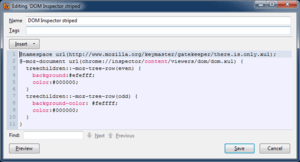Stylish
 | |
|
Screenshot of Stylish | |
| Developer(s) |
Jason Barnabe (Firefox, Chrome, and Opera versions) |
|---|---|
| Initial release | 9 October 2005[1] |
| Stable release | |
| Repository |
Mozilla version |
| Operating system | Cross-platform |
| Type |
Mozilla extension |
| License |
GPLv3 (Firefox, Chrome, and Opera versions) |
| Website | userstyles.org |
Stylish is an open-source browser extension that can apply a user-supplied style sheet to a web page, in addition to the Cascading Style Sheets provided by the website itself, to customize and personalize the appearance of the page. A user style may be more or less selective, targeting one specific web page, or several, or all of the pages on one or more domains, or every page on the web.
Mozilla-based web browsers (Firefox, Mozilla Thunderbird) and Chromium-based browsers (Google Chrome, Flock, Opera 15+) are supported with multiple implementations of the extension.[3] A similar but unrelated extension provides the same functionality in Apple Safari. Firefox for Android users can also download the add-on, but creating and editing styles is not supported. All can download and install stylesheets from a companion website, where members can upload and share their custom styles.[7]
Technical details
User styles are CSS style sheets designed to alter the appearance of one, some, or all sites. Stylish for Firefox can additionally style the skin of the browser itself, but the Android version does not support this because the user interface is built in native Android code. The styles are applied only to the targets specified. Individual user styles can be enabled or disabled without having to restart the browser.
User styles are added to the CSS rules provided by the site, but can also override the site's styling (often requiring the !important keyword for each replacement rule). The most common uses are ad-blocking, applying a new color scheme, and eliminating unwanted page elements.[8]
There are three classes of user styles. Site styles change the appearance of a particular web site. Global styles change the appearance of all web sites. App styles change the appearance of the Firefox user interface, only supported on Firefox. It is similar to the userChrome.css CSS file used by Firefox and Mozilla-based browsers.[9]
Comparison to Greasemonkey
Stylish is often compared to Greasemonkey, another Mozilla extension that allows client-side manipulation of web pages. Greasemonkey's user scripts are essentially dynamically inserted JavaScript that can alter a page's appearance or functionality, while Stylish uses CSS, which can only alter appearance.
Userstyles.org holds user-submitted styles, most of which can be converted to Greasemonkey scripts. These also have the option of being added to Greasemonkey.
References
- ↑ See the posted date on Stylish topic on MozillaZine Forums where Stylish was announced for the first time. The post itself had been edited.
- ↑ Stylish version history on addons.mozilla.org.
- 1 2 "Stylish". Chrome Web Store. Retrieved 19 October 2016.
- ↑ Official Stylish for Safari homepage
- ↑ "1.9.2 - 350d/stylish@ea6df1e". GitHub. Retrieved 19 October 2016.
- ↑ "Stylish extension". Opera add-ons. Retrieved 20 October 2016.
- ↑ "Restyle the web with Stylish! - userstyles.org". Retrieved 19 October 2016.
- ↑ "Make the whole Web look better with Stylish," Nathan Willis, Mon 7 May 2007.
- ↑ mozillaZine knowledge base entry: userChrome.css
